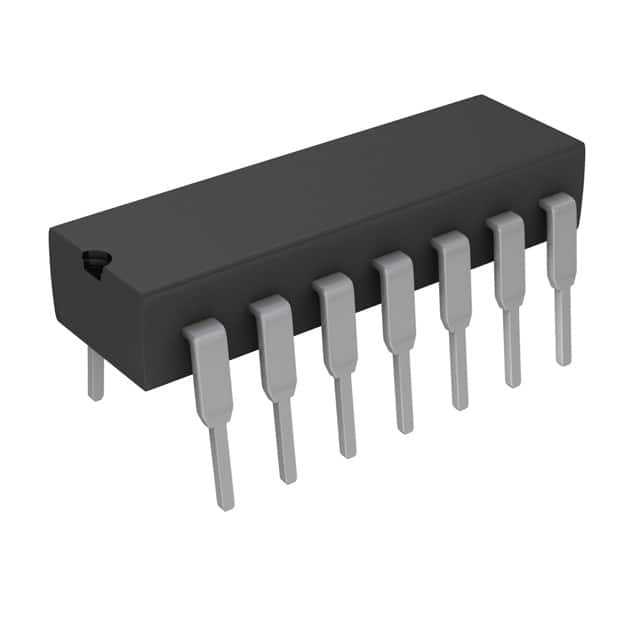CD4073BE
Basic Information Overview
- Category: Integrated Circuit (IC)
- Use: Logic Gate
- Characteristics: Triple 3-input AND gate
- Package: DIP-14 (Dual In-line Package with 14 pins)
- Essence: Digital logic gate for logical AND operations
- Packaging/Quantity: Typically sold in packs of 10 or more
Specifications
- Supply Voltage Range: 3V to 18V
- Input Voltage Range: 0V to VDD
- Output Voltage Range: 0V to VDD
- Operating Temperature Range: -55°C to +125°C
- Propagation Delay Time: 60ns (typical)
Detailed Pin Configuration
- Input A1
- Input B1
- Output Y1
- Input A2
- Input B2
- Output Y2
- GND (Ground)
- Input C
- Output Y3
- Input B3
- Input A3
- VDD (Supply Voltage)
- Output Y
- NC (No Connection)
Functional Features
- Triple 3-input AND gate: Allows three separate inputs to be logically ANDed together.
- High Noise Immunity: The CD4073BE is designed to have a high tolerance for noise, ensuring reliable operation even in noisy environments.
- Wide Supply Voltage Range: Can operate within a wide range of supply voltages, making it compatible with various systems.
- Low Power Consumption: Consumes minimal power, making it suitable for battery-powered devices.
Advantages
- Versatile Logic Function: The CD4073BE provides a flexible and essential building block for digital logic circuits.
- Compact Package: The DIP-14 package allows for easy integration into circuit boards.
- Cost-Effective: Available at an affordable price, making it a popular choice for hobbyists and professionals alike.
Disadvantages
- Limited Input/Output Options: The CD4073BE only offers three inputs and one output, which may restrict its use in complex logic circuits.
- Propagation Delay: The propagation delay of 60ns may limit its application in high-speed systems.
Working Principles
The CD4073BE is based on CMOS (Complementary Metal-Oxide-Semiconductor) technology. It consists of multiple transistors that are interconnected to form the logic gate circuit. When all input signals are high (logic level 1), the output will be high. Otherwise, the output will be low (logic level 0).
Detailed Application Field Plans
- Digital Logic Circuits: The CD4073BE can be used in various digital logic applications, such as data processing, arithmetic operations, and control systems.
- Microcontroller Interfacing: It can serve as an interface between microcontrollers and other digital devices, enabling communication and control.
- Signal Conditioning: The CD4073BE can be utilized to condition and process digital signals in various electronic systems.
Detailed and Complete Alternative Models
- CD4081B: Quad 2-input AND gate
- CD4071B: Quad 2-input OR gate
- CD4069UB: Hex Inverter
Note: These alternative models offer different logic functions but have similar characteristics and pin configurations.
Word count: 315 words
10个与CD4073BE在技术解决方案中的应用相关的常见问题及解答
Sure! Here are 10 common questions and answers related to the application of CD4073BE in technical solutions:
Q: What is CD4073BE? A: CD4073BE is a quad 2-input OR gate integrated circuit (IC) that can be used in various digital logic applications.
Q: What is the operating voltage range for CD4073BE? A: CD4073BE operates within a voltage range of 3V to 18V.
Q: Can CD4073BE be used as an AND gate? A: No, CD4073BE is specifically designed as an OR gate and cannot function as an AND gate.
Q: How many OR gates are there in CD4073BE? A: CD4073BE contains four independent OR gates in a single IC package.
Q: What is the maximum output current of CD4073BE? A: The maximum output current of CD4073BE is typically around 8mA.
Q: Can CD4073BE be used in high-speed applications? A: CD4073BE is not optimized for high-speed applications and is more suitable for low to moderate speed digital logic circuits.
Q: What is the recommended power supply decoupling for CD4073BE? A: It is recommended to use a 0.1μF ceramic capacitor placed close to the power supply pins of CD4073BE for proper decoupling.
Q: Can CD4073BE operate at different temperature ranges? A: Yes, CD4073BE can operate within a temperature range of -55°C to +125°C.
Q: Is CD4073BE compatible with TTL logic levels? A: Yes, CD4073BE is compatible with TTL logic levels and can be used in mixed logic systems.
Q: What are some common applications of CD4073BE? A: CD4073BE is commonly used in applications such as digital signal processing, data communication, control systems, and general-purpose logic circuits.
Please note that the answers provided here are general and may vary depending on specific datasheet specifications and application requirements.


